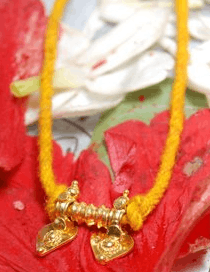Pushpaka Brahmin
Pushpaka Brahmin is a generic term that refer to a group of various Hindu Brahmin castes of Kerala in the Ambalavasi community.[1] Pushpaka Brahmin include primarily two castes - Pushpakas (or Pushpaka Unnis) and Nambeesanas, who were assigned the job of tending flowers and making garlands in the Hindu temples and were given rights to teach sacred texts and Sanskrit language in the Pathasalas associated with Hindu temples. Later some other communities like Theeyatt Unnis, Kurukkals, Puppallis etc. having similar culture and temple related jobs were also considered to be Pushpaka Brahmins.[2]
Customs
- The punyaha or purificatory ceremony after pollution for Pushpaka Brahmins was performed through the agency of Namboothiris. At the present time, learned men from Pushpaka Brahmins are employed for this purpose.
- The punyaha of Nambeesans was performed by Pushpakans or Nambeesans themselves.
- The neck ornament of women was Cheruthalikkoottam, and the ear ornament was Kathila.

Pushpaka Thali - Wedding pendant of Pushpaka Brahmin women
- Namboothiri women (Antharjanams) were not allowed to wear coloured dress. They were supposed to wear only white dress. They were not allowed to pierce nose. Further, a Namboothiri woman was not allowed to look at any man other than her husband, father, grandfather or her brothers on either side. Namboothiri women were not allowed to move out of the house without a maid. These types of restrictions were not generally observed by Pushpaka Brahmin women.
- Brahmanis (women of Nambeesans) sing religious songs on the occasion of marriage among all castes from Kshatriyas to Nāyars.[3] However, Pushpaka women or Kurukkal women never go out to sing on marriage occasions.
- During Achamana, Namboothiris were not allowed to take bath before sunrise. Such a restriction was not observed by Pushpaka Brahmins.
- In the wedding rituals (i.e. Vivaha), a Namboothiri bride always wear white dress while the Pushpaka bride will wear coloured dress, preferably red. The auspicious thread which is knotted around the bride's neck is referred to by Pushpakabrahmins as Mangalyasutra, whereas it is referred to by Namboodiris as Kanthasutra. In a Pushpaka Brahmin marriage, it is the groom who ties it around the bride's neck, whereas in a Namboodiri marriage, it is the bride's father who ties the Kanthasutra to bride's neck.
- Like Namboothiris, Pushpaka Brahmins also wear only one "Poonool" (Yajnopaveetham, sacred thread) even after marriage, whereas Paradesi brahmins wear two sacred threads after marriage.
- Upon father's or mother's death, Namboothiris were bound to observe "Deeksha" for one year and at the end of "Deeksha" on the 12th month, Sapindi was performed. Pushpaka Brahmins generally didn't practice this one year Deeksha.
References
- ↑ Rose, Suma (2004). Polity, Society, and Women: With Special Reference to Travancore, 1700-1900 A.D. Carmel International Publishing House. p. 217. ISBN 9788187655374. Retrieved 2013-04-30.
- ↑ Report of the Commission for Reservation of Seats in Educational Institutions, Kerala, 1965. Kerala: Commission for Reservation of Seats in Educational Institutions. 1965.
- ↑ Sarabhai, Mallika (1994). Performing Arts of Kerala. Mapin Pub.
This article is issued from
Wikipedia.
The text is licensed under Creative Commons - Attribution - Sharealike.
Additional terms may apply for the media files.